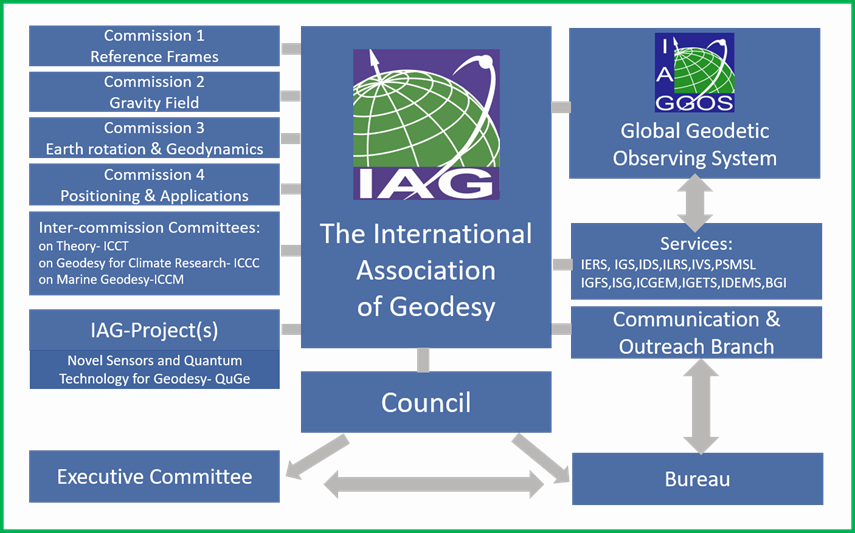About IAG
The International Association of Geodesy (IAG) is a scientific association in the field of geodesy. It promotes scientific cooperation and research in geodesy on a global scale and contributes to it through its various research bodies. It is a constituent association of the International Union of Geodesy and Geophysics (IUGG).
The IAG as an international scientific organization is one of the oldest of this kind. Its long and distinguished history goes back to 1862, when the "Mitteleuropäische Gradmessung" was established. This organization was formed to promote scientific work in geodesy in Central Europe, following a proposal by J.J. Baeyer in 1861. In 1867, its name was changed to "Europäische Gradmessung", since several European countries had joined. In 1886, the name was changed to "Internationale Erdmessung", emphasizing the need for international cooperation to solve the scientific geodetic tasks. In French and English this name resulted in "International Association of Geodesy (IAG)".
The Mission of the IAG is the advancement of geodesy. The IAG implements its mission by advancing geodetic theory through research and teaching, by collecting, analysing, modelling and interpreting observational data, by stimulating technological development and by providing a consistent representation of the figure, rotation and gravity field of the Earth and planets, as well as their temporal variations.
IAG Organization Structure

The IAG is organised, operates and works in accordance with its Statutes and Bylaws.
The administrative work of the IAG is performed by the Council, the Executive Committee (EC) and the Bureau. The Council determines the strategy and elects the EC and the Bureau members. The EC implements and advances the strategy. The Bureau administers the affairs of the IAG: it consists of the President, the Vice President and the Secretary General. To assist the Secretary General in his/her duties the IAG-Office is established at his/her home institution.
The scientific work of the Association is performed within a structure consisting of Commissions, Inter-commission Committees, Services, the Global Geodetic Observing System (GGOS), IAG Projects and the Communication and Outreach Branch (COB).
The COB provides communication, information and outreach links to the members of the IAG, to other scientific organizations and to the world as a whole.
IAG Objectives
- To study, at the highest possible level of accuracy, all geodetic problems related to Earth observation and global change, including:
- Definition, establishment, and maintenance of global and regional reference systems for interdisciplinary use,
- Rotation of the Earth and planets,
- Positioning and deformation,
- Gravity field,
- Ocean, ice and sea level,
- Atmosphere and hydrosphere,
- Time and frequency transfer.
- to foster geodetic research and development,
- to support and maintain geodetic reference systems,
- to provide observational and processed data, standards, methodologies and models,
- to stimulate development of space techniques to increase the resolution of geodetic data,
- to initiate, coordinate and promote international cooperation,
- to promote the development of geodetic activities across the globe, especially in developing countries.
IAG Meetings
The IAG holds its own “General Assembly” every four years in conjunction with the General Assembly of the IUGG, at the same time and the same place. In addition, IAG organizes “Scientific Assemblies”, generally every 4 years, in the mid-term between General Assemblies. IAG or IUGG Resolutions are voted and released during the assemblies.
The IAG sponsors or supports numerous international symposia and workshops covering broad fields of Geodesy and closely associated sciences and engineering.
IAG Publications
The IAG publications include the Journal of Geodesy, the IAG Symposia series, the Geodesist’s Handbook, the “Travaux de l’ Association Internationale de Géodésie”, the IAG special publications and the IAG Newsletter.
IAG Fellows
According to the IAG By-laws, the IAG Executive Committee may appoint past officers of the IAG as Fellows. The current list of the IAG Fellows is available here.
| DOCUMENTS |
| Fellows 1991-2023.pdf |